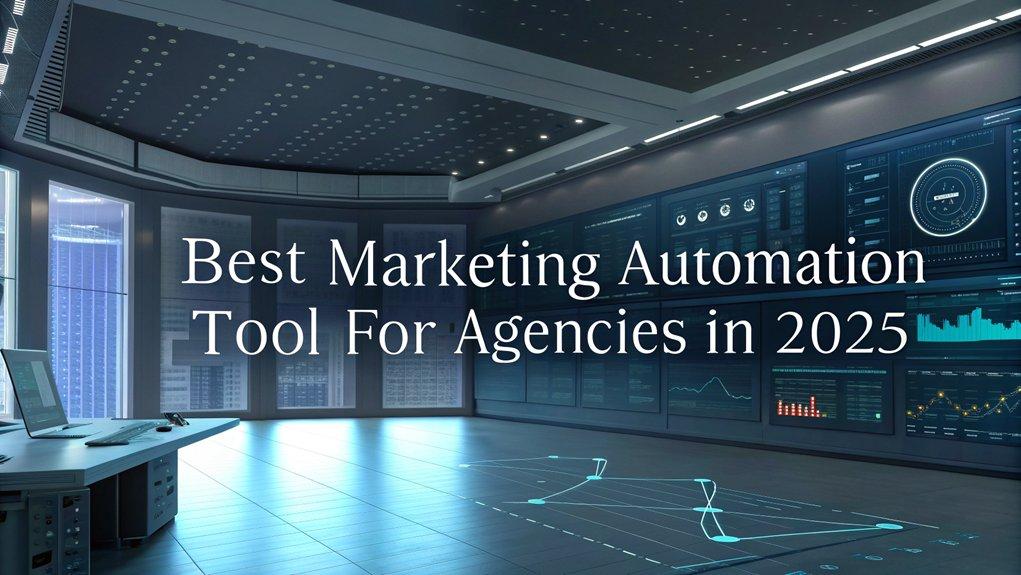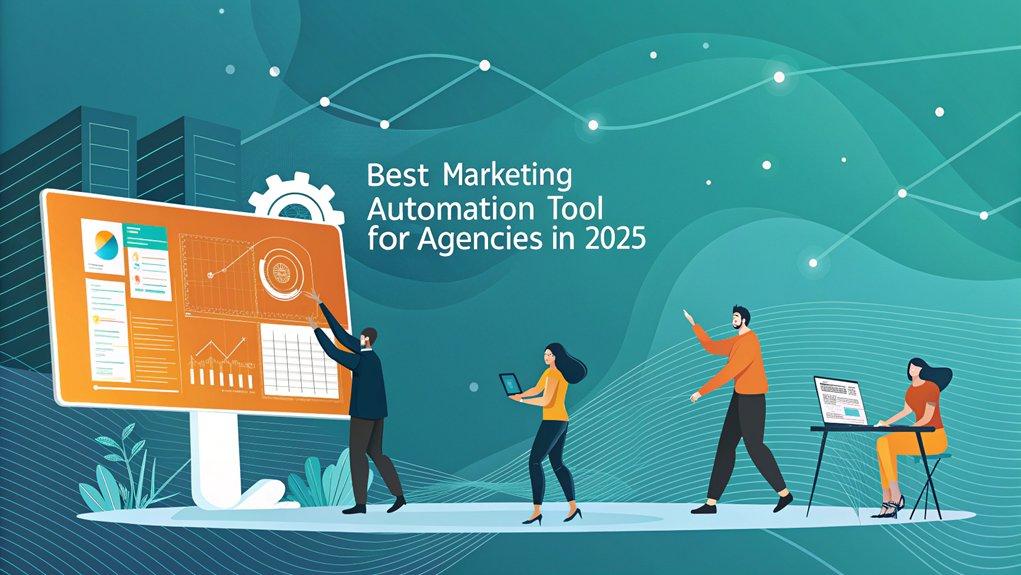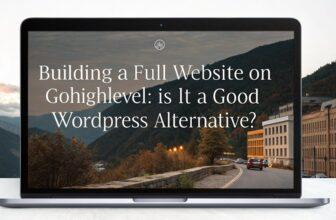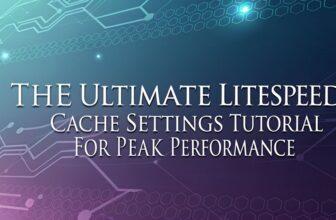For agencies in 2025, HubSpot and ActiveCampaign reign supreme in marketing automation with their comprehensive CRM features and multi-channel capabilities. HubSpot is ideal for lead generation, while ActiveCampaign excels in customer retention. If you focus on e-commerce, Klaviyo is unmatched with its 300+ integrations. Meanwhile, Mailchimp offers affordability without sacrificing core functionalities. Each tool leverages AI and predictive analytics for superior targeting, promising valuable insights and optimization. Explore further for detailed insights and comparisons.
Key Facts Summarized
- HubSpot excels with comprehensive CRM capabilities and multi-channel support, ideal for agencies seeking robust marketing automation solutions.
- ActiveCampaign offers advanced automation and personalization features, boosting customer engagement and retention rates for agencies.
- Klaviyo provides over 300 eCommerce-focused integrations, making it a top choice for agencies working with online retail clients.
- Pardot’s advanced lead scoring is perfect for B2B agencies needing precise targeting and engagement strategies.
- Mailchimp offers an affordable, user-friendly platform suitable for startups and small agencies with budget constraints.
Top Features to Look for in a Marketing Automation Tool
When evaluating marketing automation tools, advanced automation capabilities should be at the top of your checklist. These features enable personalized messaging and segmentation to create targeted campaigns based on user behavior and demographics.
Multi-channel support is vital, allowing you to manage campaigns across email, SMS, and social media effectively. A user-friendly interface ensures smooth navigation and efficient campaign management, reducing the learning curve for your team.
Integration options with existing systems, such as CRM and eCommerce platforms, enhance marketing efficiency by ensuring seamless data flow. Advanced analytics and comprehensive reporting are crucial for tracking campaign performance, measuring ROI, and informing future strategies. GoHighLevel, for instance, provides email marketing capabilities combined with automated workflows to streamline customer engagements.
Together, these elements maximize your marketing automation tool’s impact, driving better outcomes and elevating your agency’s capabilities.
The Role of AI in Marketing Automation for Agencies
You’re seeing a transformation in marketing automation as AI tools enhance campaign optimization, with predictive analytics forecasting customer behavior for more precise strategy adjustments.
By automating personalized content creation, AI enables agencies to deliver hyper-targeted messaging that boosts engagement and ROI.
With platforms integrating real-time analytics, you can swiftly adapt your marketing tactics, ensuring your campaigns consistently achieve optimal results. Implementing strategic automation enhances customer experience through tailored processes and consistent communication.
AI-driven Campaign Optimization
Although the digital marketing landscape is constantly evolving, leveraging AI-driven campaign optimization is proving indispensable for agencies aiming to boost their marketing automation efforts.
By utilizing predictive analytics, you can anticipate customer behavior, refining targeting strategies for enhanced engagement. Advanced algorithms empower you to personalize messaging effectively, tailoring content for diverse audience segments.
Tools like ActiveCampaign and HubSpot offer email marketing automation features such as send-time optimization and automated A/B testing, driving up open and click-through rates.
AI not only streamlines campaign development by generating content suggestions but also optimizes existing materials based on performance data.
With these capabilities, agencies often see a 30% rise in return on investment, thanks to improved targeting and personalization efforts.
Predictive Analytics in Marketing
Building on the momentum from AI-driven campaign optimization, predictive analytics in marketing automation takes your strategies to the next level. By leveraging AI algorithms, marketing automation platforms analyze historical data to forecast future customer behaviors. This empowers you to craft personalized marketing that boosts conversion rates by 20-30%.
- Identifying high-value segments: Use predictive models to discern valuable customer groups, tailoring your marketing strategies for maximum impact.
- Real-time decision-making: Respond instantly to market dynamics, enhancing campaign responsiveness and overall effectiveness.
- Enhancing retention efforts: Anticipate potential churn and proactively engage at-risk customers, bolstering long-term loyalty.
Incorporating predictive analytics refines your approach, sharpening targeting precision and optimizing every interaction.
Ultimately, this integration revolutionizes how you connect with customers, driving superior results in a competitive marketplace.
Personalized Content Automation
While agencies strive to enhance customer engagement, personalized content automation stands as a game-changer, leveraging AI to transform marketing strategies. By utilizing AI-driven predictive analytics, you can analyze customer behavior and preferences, enabling targeted messaging that boosts engagement rates. Advanced tools like Jasper streamline content creation, producing high-quality copy that resonates with audiences.
| Feature | Benefit |
|---|---|
| Targeted Messaging | Increases engagement rates |
| Real-time Data | Keeps content relevant and timely |
| AI-driven Predictive Analytics | Optimizes marketing strategies |
Automation platforms adjust content based on real-time data, ensuring marketing messages are timely. As of 2025, AI adoption in personalized content automation will rise by over 30%, crucial for agency growth. This integration not only enhances customer experiences but also maximizes ROI, cementing its role in competitive markets.
Comparing the Best Marketing Automation Tools of 2025
In 2025, choosing the right marketing automation tool hinges on analyzing features and pricing; HubSpot and ActiveCampaign lead with comprehensive CRM and multi-channel capabilities, while Klaviyo excels in eCommerce with over 300 integrations.
For B2B agencies, Pardot’s advanced lead scoring justifies its $1,250/month cost, targeting larger enterprises.
Meanwhile, startups benefit from Mailchimp and GetResponse’s affordability and simplicity, with emerging platforms like Insider offering seamless cross-channel campaign management. Additionally, leveraging data-driven insights can enhance your decision-making process when selecting the most suitable tool for your agency’s needs.
Features and Pricing Comparison
When evaluating the top marketing automation tools of 2025, understanding the features and pricing options is crucial for making an informed decision. Each platform offers unique marketing automation strategies tailored to different needs.
For instance, Klaviyo starts at $30/month, spotlighting advanced segmentation and behavior-based email marketing. ActiveCampaign, at $9/month, merges robust automation capabilities with CRM functionalities, ideal for integrating platforms. HubSpot, priced at $50/month, delivers a comprehensive marketing suite, combining email marketing, content management, and detailed analytics.
- Mailchimp offers a user-friendly interface and customizable email templates, with plans starting at $10/month, perfect for small businesses.
- LeadSquared provides lead automation and powerful drip campaigns with customized pricing, suitable for agencies with diverse needs.
- Pricing varies significantly, catering to different organizational scales and requirements.
Integration and Usability Analysis
Understanding the features and pricing of marketing automation tools sets the stage for examining how these platforms integrate into existing workflows and enhance usability.
In 2025, HubSpot and ActiveCampaign shine with seamless integrations across over 300 platforms, offering agencies customizable workflows that streamline operations.
Klaviyo’s advanced segmentation allows agencies to craft targeted campaigns quickly, leveraging user behavior and demographics.
Mailchimp caters to varying agency sizes with a user-friendly interface, ensuring ease of use with minimal training.
Buffer’s collaborative features facilitate social media management and data tracking from a unified dashboard, essential for agencies juggling multiple channels.
Meanwhile, Storylane’s integration with CRM systems like Salesforce empowers agencies with robust data tracking capabilities, supporting an engaging, self-paced user experience.
Integrations and Compatibility With Other Platforms
Navigating the world of marketing automation requires a keen understanding of integrations and platform compatibility. Leading marketing automation tools offer extensive integrations crucial for optimizing your campaign performance.
For instance, HubSpot and ActiveCampaign provide over 300 pre-built integrations with platforms like Shopify and Salesforce, ensuring seamless compatibility for efficient lead management. Klaviyo excels in the eCommerce sector, enabling direct synchronization with popular online stores for enhanced email marketing efforts.
- CRM systems compatibility: Tools like Pardot streamline lead management, driving better marketing effectiveness.
- Social media management: Platforms like Buffer and Hootsuite integrate with major social networks, centralizing your social media activities.
- Customer Data Platforms: Insider’s platform enhances targeting through robust data exchange capabilities.
These integrations empower you to maximize marketing automation tools, making your campaigns more effective.
Pricing and Budget Considerations for Agencies
How much should agencies really spend on marketing automation tools to get the best value? With pricing tiers ranging from $5/month to $1,250/month, agencies must evaluate their budget against the features required.
Consider total cost of ownership, including recurring costs and potential add-ons. Tools like ActiveCampaign and Mailchimp offer free trials or low-cost paid plans starting at $9/month and $10/month, respectively, ideal for smaller agencies managing tight budgets.
Assess whether essential functionalities are available at lower price points—it’s crucial to avoid overpaying for advanced features that aren’t necessary. Additionally, conducting market research allows agencies to better understand customer needs and tailor their tool choices accordingly.
Don’t overlook custom pricing options or discounts based on list size or contract length, as these can offer substantial savings.
Strategic evaluation ensures alignment with your financial strategy.
Real-World Use Cases and Success Stories
When evaluating the effectiveness of marketing automation tools, real-world use cases provide invaluable insights into their potential impact. For instance, a marketing agency using HubSpot saw a 300% boost in lead generation in just six months. They achieved this by leveraging CRM and inbound marketing for targeted campaigns.
Similarly, an e-commerce brand experienced a 25% increase in customer retention through ActiveCampaign’s personalized email automation, tailored to user behavior and purchase history.
Consider these success stories:
- 50% reduction in manual follow-ups: A digital agency streamlined lead nurturing with Marketo, increasing qualified leads.
- 40% boost in demo requests: A SaaS company improved engagement with interactive demo experiences via Storylane.
- 60% improvement in donor engagement: A non-profit organization enhanced segmentation and automation capabilities using GetResponse.
Moreover, utilizing data-driven insights can further capitalize on growth opportunities and improve the effectiveness of marketing strategies in today’s competitive landscape.
Future Trends in Marketing Automation Technology
As marketing automation technology evolves, agencies must prepare for transformative shifts driven by AI and machine learning.
Predictive analytics will become increasingly powerful, allowing you to anticipate customer behavior and refine campaign strategies.
Cross-channel automation will enable a seamless integration of platforms like email, SMS, and social media, creating a cohesive experience for your audience.
Personalized content will be more dynamic, using real-time data to craft messages that truly resonate with individual preferences.
As data privacy becomes a cornerstone, marketing automation tools will prioritize secure data handling, aligning with GDPR and CCPA regulations.
Additionally, no-code and low-code platforms will revolutionize accessibility, empowering you to deploy sophisticated solutions without needing extensive technical expertise.
Moreover, adopting AI-driven personalization can significantly enhance customer satisfaction and conversion rates, ensuring your marketing strategies remain competitive in the evolving landscape.
Frequently Asked Questions
What Is the Future of Marketing Automation?
You’ll find marketing automation’s future focuses on seamless integration across channels, enhancing customer experience through advanced AI and machine learning.
These technologies will optimize audience targeting and personalize messaging, boosting campaign ROI.
As data-driven decisions become crucial, platforms will offer real-time analytics and insights into customer behavior.
Expect more intuitive interfaces, simplifying usage, and the rise of CDPs to refine audience segmentation and strategy personalization, elevating marketing effectiveness.
Which Marketing Automation Tool Is Best?
When choosing the best marketing automation tool, you need to consider your agency’s specific needs.
HubSpot stands out for its all-in-one capabilities, making it a versatile choice.
If you’re focused on customer engagement, ActiveCampaign offers advanced personalization.
For eCommerce, Klaviyo’s segmentation is unmatched.
Mailchimp is perfect for small agencies needing simplicity, while Pardot suits B2B lead generation.
Analyze these options based on your goals and budget to decide.
Which Automation Tool Will Be in Demand in Future?
Imagine the future where your marketing tool is a symphony conductor, orchestrating seamless campaigns across email, SMS, and social media.
In 2025, you won’t just want automation; you’ll need tools that integrate with CRMs, utilizing AI for precise audience segmentation and personalized messaging.
These platforms, rich in analytics, will be your compass, guiding you through data-driven decision-making.
Customer journey optimization will be your secret weapon, enhancing engagement and ROI effortlessly.
Which Type of CRM Is Used for Marketing Automation?
You’re likely exploring CRM types that excel in marketing automation, focusing on those that streamline tasks like lead generation and segmentation.
Look for CRMs offering integrated email marketing, social media tools, and analytics.
Prioritize systems like HubSpot or ActiveCampaign, which provide dynamic segmentation and personalized content based on user behavior.
Ensure they integrate seamlessly with other tools for optimal data flow, enhancing engagement and retention through insightful customer interaction analysis.
Conclusion
In 2025, a staggering 85% of agencies report increased efficiency through marketing automation tools. By leveraging AI, these platforms not only streamline operations but also enhance client engagement. As you consider your options, focus on tools offering seamless integrations and flexible pricing to suit your budget. Real-world successes highlight the transformative power of these technologies. Stay ahead by embracing future trends, ensuring your agency remains competitive and innovative in an ever-evolving digital landscape.









